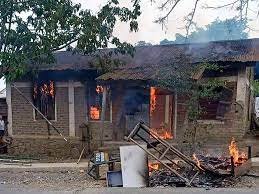In recent events, Manipur, a northeastern state in India, has witnessed a surge of ethnic violence leading to a significant loss of life, displacement of residents, and widespread destruction of property. At the core of this conflict lies the deep-rooted divide between the hill-dwelling communities and the urban populations residing in the valley. The conflict is fueled by disparities in education, infrastructure, employment opportunities, and economic development, exacerbating tensions and creating a volatile situation.
The population of Manipur can be broadly classified into two groups. The first comprises the better-educated urban dwellers living in the valley, predominantly consisting of Manipuri-speaking Hindus and a notable Muslim minority. The valley residents enjoy access to essential amenities such as clean drinking water, cooking fuel, and healthcare facilities. The valley region also dominates the public sector job market, attracting a higher share of industries and serving as a hub for tourism.
On the other hand, the hill-dwelling communities, primarily comprising various ethnic tribes, face significant challenges. Many of these communities live in remote areas covered by dense forests, which limit access to basic necessities and services. They often struggle with inadequate healthcare facilities, limited educational opportunities, and a lack of proper infrastructure. Moreover, the hills have traditionally been neglected in terms of economic development, leading to higher rates of unemployment and poverty within these communities.
The socioeconomic disparities between the hill and valley regions have been a longstanding issue, exacerbating tensions and grievances among different communities. The valley, with its better infrastructure and employment opportunities, has attracted a larger share of investment and development, resulting in a more prosperous economy. The presence of industries and tourism further bolsters the valley’s economic prospects, contributing to its relative affluence.
In contrast, the hills have faced neglect and a lack of focused developmental initiatives. Limited access to education, healthcare, and employment opportunities has hindered the growth and prosperity of these communities. This stark disparity has fostered a sense of marginalization and a perception of favoritism towards the valley region, leading to simmering discontent and animosity.
The recent outbreak of ethnic violence in Manipur can be attributed to the culmination of historical grievances, political rivalries, and economic disparities. The violence, characterized by clashes, vandalism, and arson, has resulted in significant loss of life and property. The attacks on houses, churches, temples, and vehicles indicate a targeted assault on cultural and religious symbols, further exacerbating tensions and deepening the divide between communities.
To address the long-standing hill-valley divide and alleviate the simmering tensions, it is crucial for the government and local authorities to adopt a multifaceted approach. This includes prioritizing equitable development, focusing on infrastructure projects, investing in education and healthcare facilities in the hill regions, and promoting economic opportunities in underprivileged areas.
Efforts should be made to foster dialogue and promote cultural exchange between the diverse communities. Encouraging mutual understanding, respect, and appreciation for different ethnicities can help bridge the divide and foster a sense of unity and shared identity.
Additionally, the government should strive to ensure the fair distribution of resources and opportunities across the state, minimizing disparities and addressing the root causes of grievances. By promoting inclusive policies and providing equal access to education, healthcare, and employment, Manipur can create an environment conducive to long-term peace and stability.
The ethnic violence in Manipur underscores the urgent need to address the long-standing hill-valley identity divide. By acknowledging and rectifying the socioeconomic disparities between these regions, fostering dialogue, and promoting inclusive policies, the government can work towards reconciliation and sustainable development. Building a society that values diversity & equality.







